U MEDIA Communications WPC370L 2.4GHz 802.11n (Draft 2.0) CardBus Card User Manual User s Manual
U-MEDIA Communications, Inc. 2.4GHz 802.11n (Draft 2.0) CardBus Card User s Manual
Manual
1
2.4GHz Wireless 802.11n (DRAFT 2.0)
PCI Adapter
User's Guide
Version 0.95
2
Copyright
This publication, including all photographs, illustrations and software, is protected under interna-
tional copyright laws, with all rights reserved. Neither this manual, nor any of the material con-
tained herein, may be reproduced without written consent of the author.
Copyright 2006
Version 1.0 (June, 2006)
Disclaimer
The information in this document is subject to change without notice. The manufacturer makes
no representations or warranties with respect to the contents hereof and specifically disclaims
any implied warranties of merchantability or fitness for any particular purpose. The manufacturer
reserves the right to revise this publication and to make changes from time to time in the content
hereof without obligation of the manufacturer to notify any person of such revision or changes.
Trademark recognition
All product names used in this manual are the properties of their respective owners and are
acknowledged.
3
Federal Communication Commission Interference Statement
This equipment has been tested and found to comply with the limits for a Class B digital
device, pursuant to Part 15 of the FCC Rules. These limits are designed to provide
reasonable protection against harmful interference in a residential installation. This
equipment generates, uses and can radiate radio frequency energy and, if not installed
and used in accordance with the instructions, may cause harmful interference to radio
communications. However, there is no guarantee that interference will not occur in a
particular installation. If this equipment does cause harmful interference to radio or
television reception, which can be determined by turning the equipment off and on, the
user is encouraged to try to correct the interference by one of the following measures:
Reorient or relocate the receiving antenna.
Increase the separation between the equipment and receiver.
Connect the equipment into an outlet on a circuit different from that to which the
receiver is connected.
Consult the dealer or an experienced radio/TV technician for help.
FCC Caution: Any changes or modifications not expressly approved by the party
responsible for compliance could void the user's authority to operate this equipment.
This device complies with Part 15 of the FCC Rules. Operation is subject to the following
two conditions: (1) This device may not cause harmful interference, and (2) this device
must accept any interference received, including interference that may cause undesired
operation.
IMPORTANT NOTE:
FCC Radiation Exposure Statement:
This equipment complies with FCC radiation exposure limits set forth for an uncontrolled
environment. This equipment should be installed and operated with minimum distance
20cm between the radiator & your body.
This transmitter must not be co-located or operating in conjunction with any other
antenna or transmitter.
The availability of some specific channels and/or operational frequency bands are
country dependent and are firmware programmed at the factory to match the intended
destination. The firmware setting is not accessible by the end user.
4
CE Mark Warning
This is a Class B product. In a domestic environment, this product may cause radio
interference, in which case the user may be required to take adequate measures.
This transmitter must not be co-located or operation in conjunction with any other
antenna or transmitter.
5
Table of Contents
Federal Communications Commission Interference statement 3
CE Mark Warning 4
Chapter 1 - Getting Started with the WPC-370L
LL
L 6
Chapter 2 - Wireless LAN Networking 7
Transmission Rate (Transfer Rate) 7
Type of Wireless Networks 7
Wireless LAN Security 11
Chapter 3 - Hardware and Wireless Utility 13
About Your 11n (Draft) Wireless PCI Adapter 13
Package Content 13
System Requirement 13
LED Definition 13
Hardware and Wireless Utility Installation 14
Using the Utility to Configure Your Network 17
Chapter 4 – Maintenance 26
Uninstall the Driver 26
Uninstall the Client Utility 26
Upgrading the Wireless Utility 26
Glossary 27

6
Chapter 1 - Getting Started with the WPC-370L
Congratulations on purchasing the WPC-370L! This manual provides information for setting up
and configuring the WPC-370L. This manual is intended for both home users and professionals.
It is not required to read some of the more technical information in this manual (such as in
“Wireless LAN Networking” and “Configuring Wireless Security”) to operate and enjoy the
WPC-370L. It is included for your reference only.
The following conventions are used in this manual:
T
HE
N
OTE SYMBOL INDICATES ADDITIONAL INFORMATION ON THE TOPIC AT
HAND.
T
HE
T
IP SYMBOL INDICATES HELPFULL INFORMATION AND TIPS TO IMPROVE
YOUR NETWORK EXPERIENCE.
T
HE
C
AUTION SYMBOL ALERTS YOU TO SITUATIONS THAT MAY DEGRADE
YOUR NETWORKING EXPERIENCE OR COMPROMISE YOUR SECURITY.
NOTE
L
IKE
N
OTES AND
T
IPS, THE
I
MPORTANT SYMBOL INDICATES INFORMATION
THAT CAN IMPROVE NETWORKING.
T
HIS INFORMATION SHOULD NOT BE OVER
-
LOOKED.

7
Chapter 2 - Wireless LAN Networking
This section provides background information on wireless LAN networking technology.
T
HE INFORMATION IN THIS SECTION IS FOR YOUR REFERENCE.
C
HANGING
NETWORK SETTINGS AND PARTICULARLY SECURITY SETTTINGS SHOULD ONLY
BE DONE BY AN AUTHORIZED ADMINISTRATOR.
Transmission Rate (Transfer Rate)
The WPC-370L provides various transmission (data) rate options for you to select. In most
networking scenarios, the factory default Fully Auto setting proves the most efficient. This
setting allows your WPC-370L to operate at the maximum transmission (data) rate. When the
communication quality drops below a certain level, the WPC-370L automatically switches to a
lower transmission (data) rate. Transmission at lower data speeds is usually more reliable.
However, when the communication quality improves again, the WPC-370L gradually increases
the transmission (data) rate again until it reaches the highest available transmission rate.
Types of Wireless Networks
Wireless LAN networking works in either of the two modes: ad-hoc and infrastructure. In infra-
structure mode, wireless devices communicate to a wired LAN via access points. Each access
point and its wireless devices are known as a Basic Service Set (BSS). An Extended Service Set
(ESS) is two or more BSSs in the same subnet. In ad hoc mode (also known as peer-to-peer
mode), wireless devices communicate with each other directly and do not use an access point.
This is an Independent BSS (IBSS).
To connect to a wired network within a coverage area using access points, set the WPC-370L
operation mode to Infrastructure (BSS). To set up an independent wireless workgroup without an
access point, use Ad-hoc (IBSS) mode.
A
D
-H
OC
(IBSS) N
ETWORK
Ad-hoc mode does not require an access point or a wired network. Two or more wireless stations
communicate directly to each other. An ad-hoc network may sometimes be referred to as an
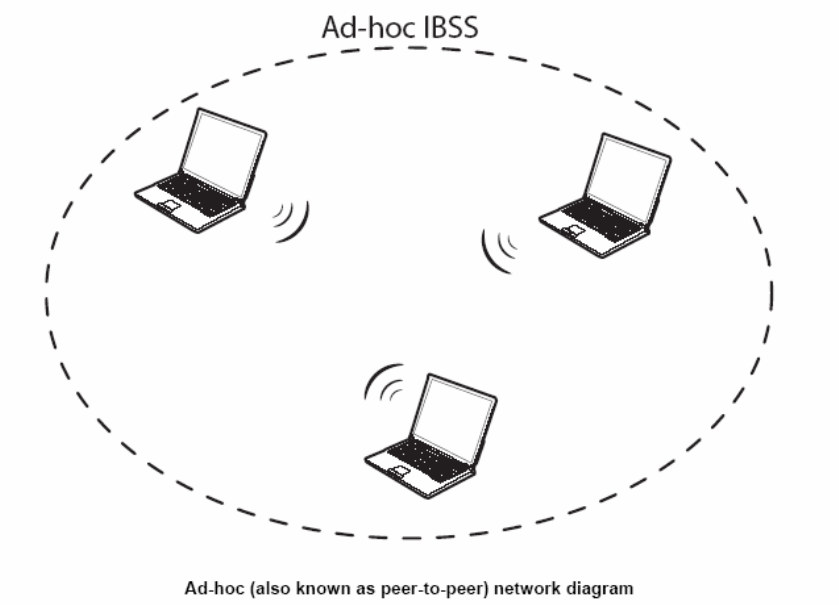
8
Independent Basic Service Set (IBSS).
To set up an ad-hoc network, configure all the stations in ad-hoc mode. Use the same SSID and
channel for each station.
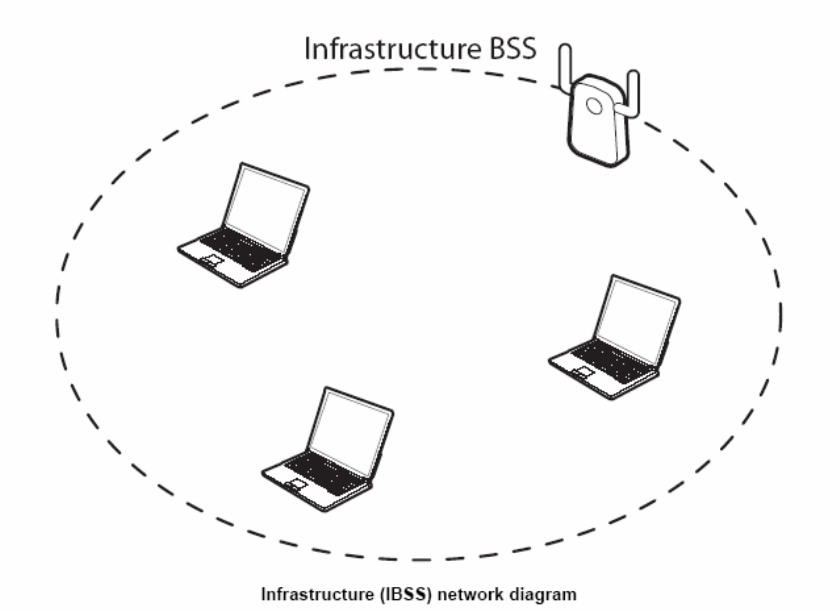
9
When a number of wireless stations are connected using a single access point, you have a Basic
Service Set (BSS).
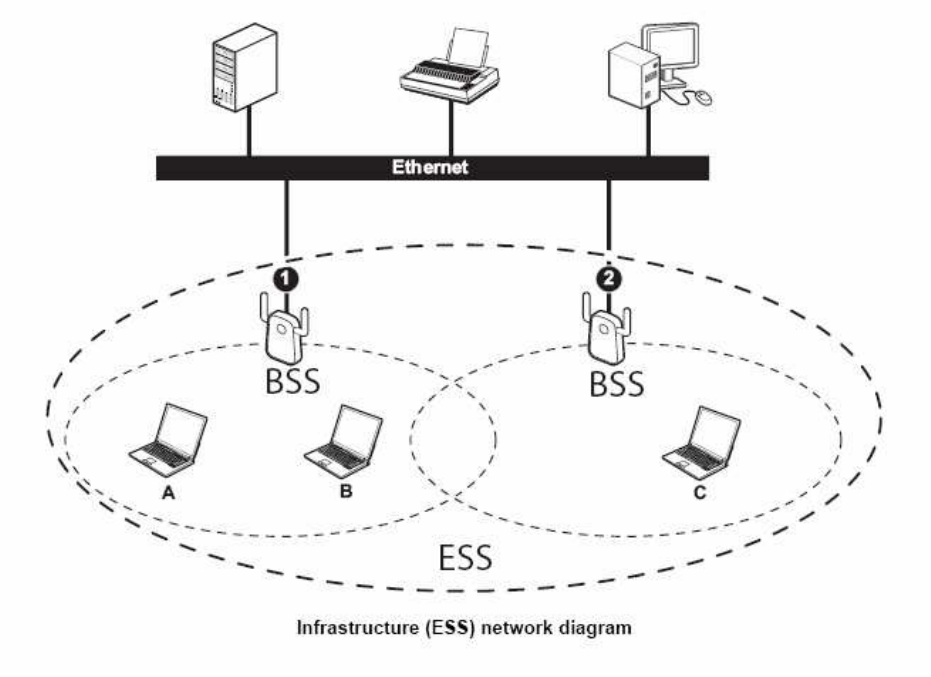
10
In the ESS diagram below, communication is done through the access points, which relay data
packets to other wireless stations or devices connected to the wired network. Wireless stations
can then access resources, such as a printer, on the wired network.
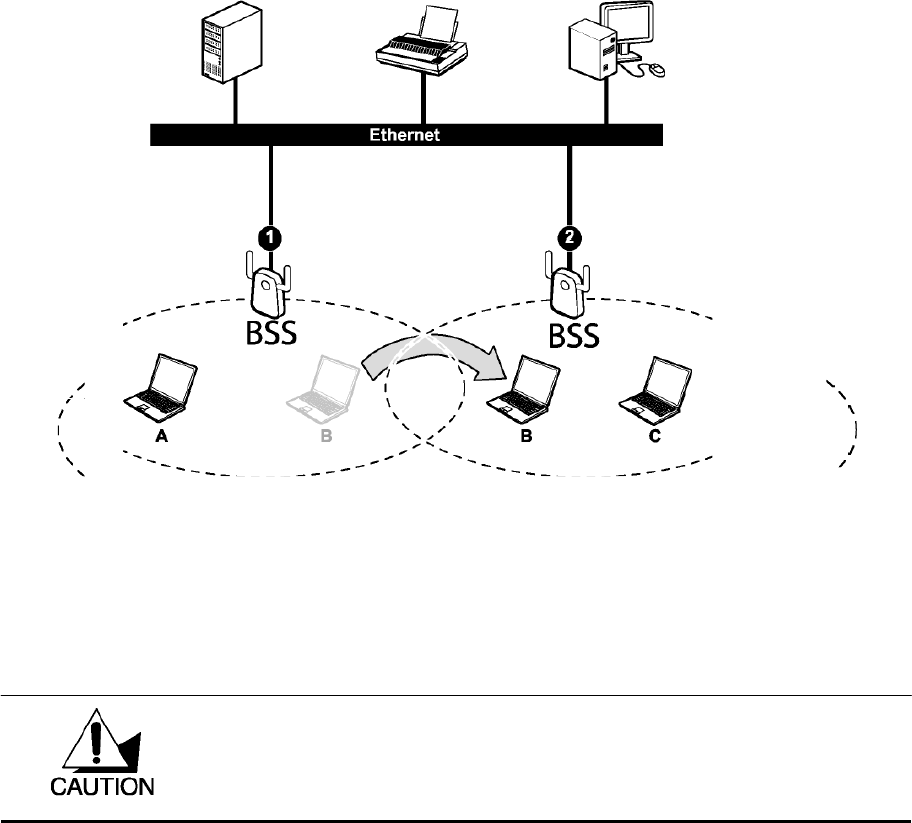
11
In an ESS environment, users are able to move from one access point to another without losing
the connection. In the diagram below, when the user moves from BSS (1) to BSS (2) the
WPC-370L automatically switches to the channel used in BSS (2).
Wireless LAN Security
Because wireless networks are not as secure as wired networks, its vital that security settings
are clearly understood and applied.
The list below shows the possible wireless security levels on your WPC-370L starting with the
most secure. EAP (Extensible Authentication Protocol) is used for authentication and utilizes
dynamic WEP key exchange. EAP requires interaction with a RADIUS (Remote Authentication
Dial-In User Service) server either on the WAN or the LAN to provide authentication service for
wireless stations.
1. Wi-Fi Protected Access (WPA)
2. IEEE802.1X EAP with RADIUS Server authentication
3. WEP Encryption
4. Unique ESSID
Roaming in an ESS network diagram
D
O
NOT ATTEMPT TO CONFIGURE OR CHANGE SECURITY SETTTINGS FOR A
NETWORK WITHOUT AUTHORIZATION AND WITHOUT CLEARLY UNDERSTANDING
THE SETTINGS YOU ARE APPLING.
W
ITH POOR SECURITY SETTINGS, SENSITIVE
DATA YOU SEND CAN BE SEEN BY OTHERS.
12
D
ATA
E
NCRYPTION WITH
WEP
The WEP (Wired Equivalent Privacy) security protocol is an encryption method designed to try to
make wireless networks as secure as wired networks. WEP encryption scrambles all data packets
transmitted between the WPC-370L and the access point or other wireless stations to keep
network communications private. Both the wireless stations and the access points must use the
same WEP key for data encryption and decryption.
There are two ways to create WEP keys in your WPC-370L.
• Automatic WEP key generation based on a password phrase called a passphrase. The
passphrase is case sensitive. You must use the same passphrase for all WLAN adapters
with this feature in the same WLAN.
• For WLAN adapters without the passphrase feature, you can still take advantage of this
feature by writing down the four automatically generated WEP keys from the Security
Settings screen of the wireless utility and entering them manually as the WEP keys in the
other WLAN adapter(s).
The WPC-370L allows you to configure up to four WEP keys and only one key is used as the
default transmit key at any one time.

13
Chapter 3 - Hardware and Wireless Utility
This chapter introduces the Adapter and prepares you to use the Wireless Utility.
About Your 11n (Draft) Wireless PCI Adapter
With the Adapter, you can enjoy wireless mobility within almost any wireless networking environment.
The following lists the main features of your Card.
Automatic rate selection.
Data rate up to 300Mbps.
Offers 64-bit, 128-bit WEP (Wired Equivalent Privacy) data encryption for network security.
Supports IEEE802.1x and WPA (Wi-Fi Protected Access).
Three external antennas.
Driver support for Windows XP/2000.
Package Content
11n (Draft) Wireless PCI Adapter
Three external antennas
Installation and Manual CD
Quick Start Guide
System Requirement
Pentium class desktop computers with at least one available PCI slot
Microsoft Windows XP or 2K
CD-ROM drive
LED Definition
The following table describes the LEDs on the 11n (Draft) Wireless PCI Adapter
STATUS POWER LED LINK LED
POWER OFF OFF OFF
POWER ON Slow Blinking OFF
Radio on without association
Two LEDs slow blinking mutually
Associated without traffic Two LEDs slow blinking together
Associated with traffic Two LEDs blinking together per traffic amount
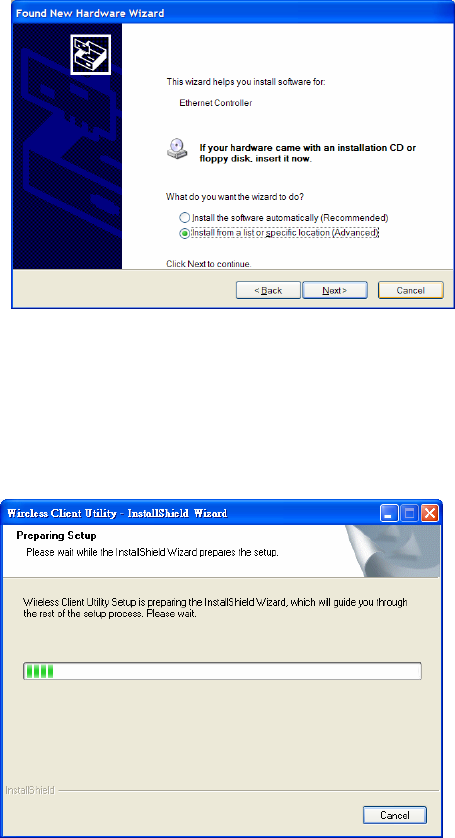
14
Hardware and Wireless Utility Installation
Follow the instructions below to install the PCI Card and Wireless Utility.
1. Turn off your computer‚ unplug the power cord and remove the computer's cover.
2. Pick a free PCI expansion slot and remover the protective bracket. Insert the Card into the slot until
it is fully seated.
3. Secure the Card bracket with the screw from step 2. Replace the computer’s cover.
4. Connect the external antenna to the Card from the SMA connector. And then, reconnect the power
cord and power on the computer.
5. After power on, you will get the “Found News Hardware Wizard” menu; click on Cancel.
6. Insert the Driver and Utility CD into CD drive.
7. If your CD Autorun is enabled, the Main Installation Menu will show. (Otherwise open your CD folder
and double-click on the “setup.exe” file)
8. The InstallShield Wizard prepares for installation.
9. The InstallShield Wizard prompts you for confirmation. Click Next on the following menu.
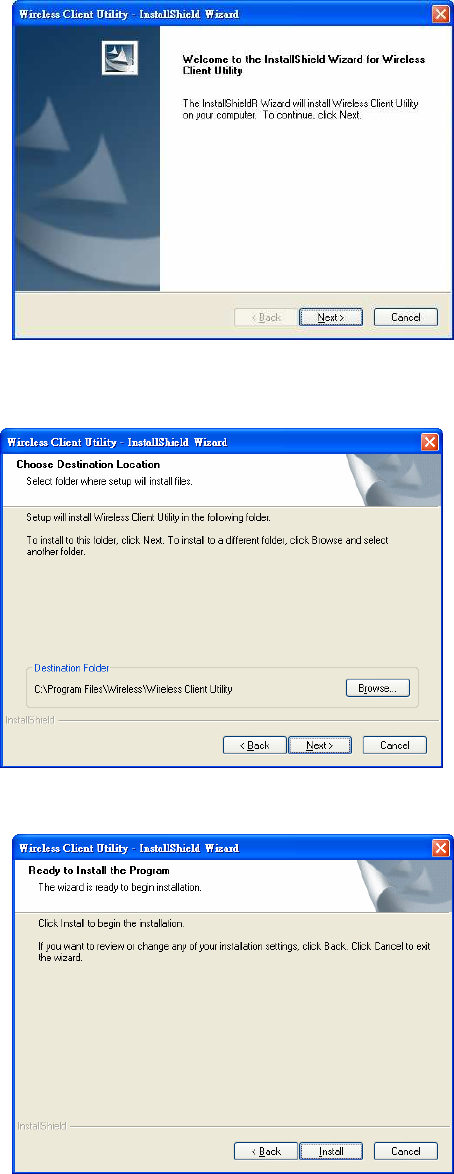
15
10. In the destination Folder screen you are asked to confirm the Destination Folder for the application
software. If you would like, you may change the destination folder to another location. Click Next.
11. The wizard is ready to begin installation. Click Install on it.
12. At the Software Installation menu click Continue Anyway.
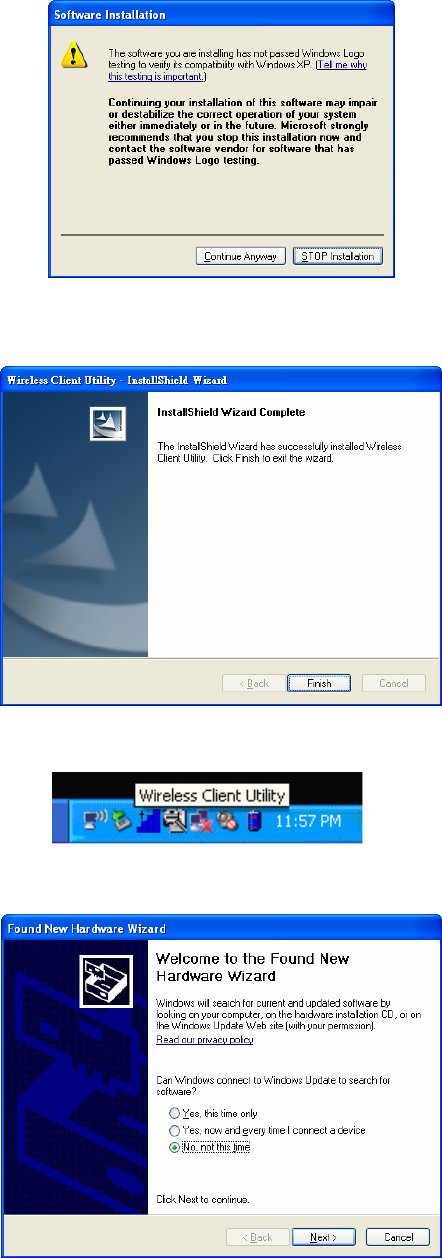
16
13. Click Finish to complete the client utility installation. Please reboot your computer.
14. After rebooting, The Client Utility icon resides on the Desktop at the System Tray automatically.
15. The OS detects the PCI Card after rebooting; the Found New Hardware Wizard window appears,
click Next to continue.
16. Choose “Install the software automatically” , and click Next.
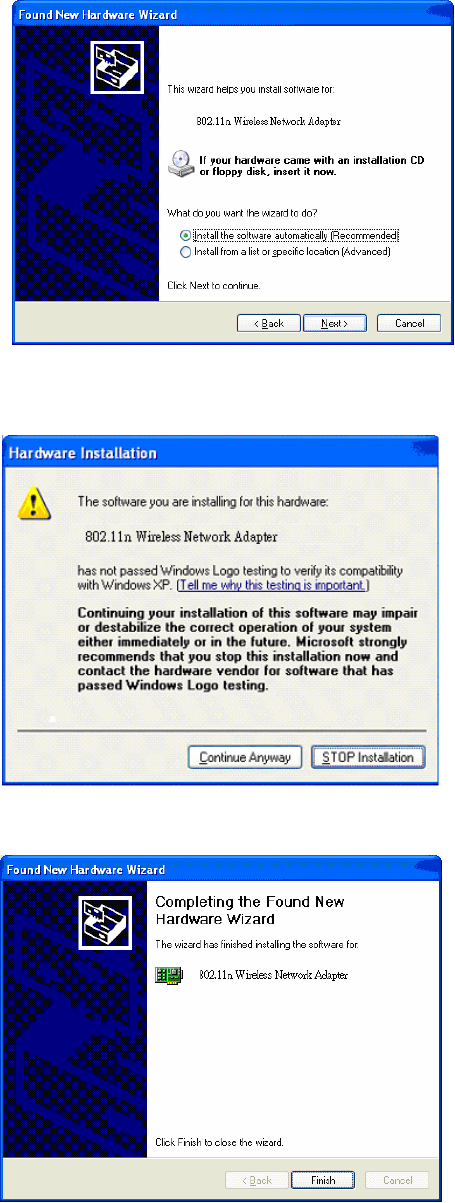
17
17. At the hardware installation menu click Continue Anyway. (Our product has been tested under
Windows XP and found to be fully compatible click Continue Anyway.)
18. The Windows has finished installing driver for the device. Click Finish to finish the installation.
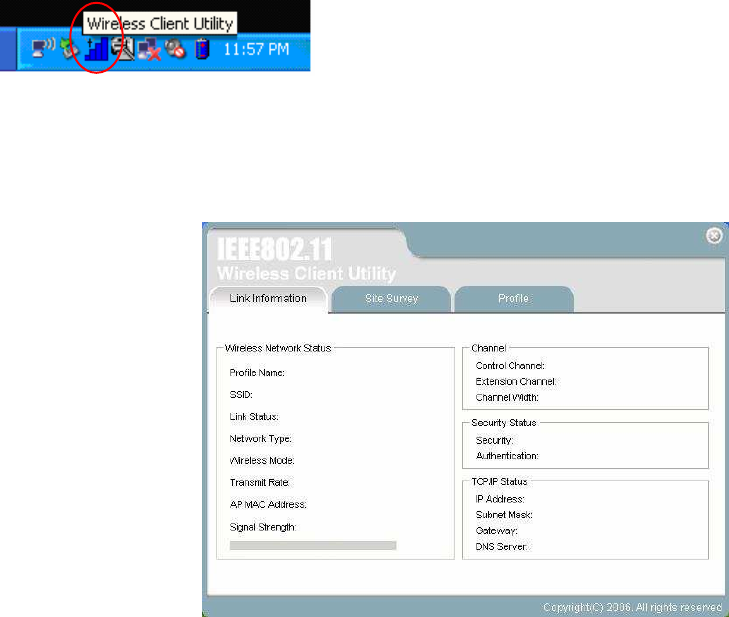
18
Using the Utility to Configure Your Network
The following are explanations on how to configure and use the Utility program. After completing the
installation procedure, a new icon as shown below will automatically appear in the lower right tray bar.
Hold your mouse pointer over the icon, and double click the left mouse button to open the Wireless Client
Utility.
The Wireless Client Utility window as shown below will appear.
The user can now use any of the management functions available in the IEEE 802.11 Wireless Client Utility.
Link Information
Click the Link Information tab to see general information about the program and its operation.
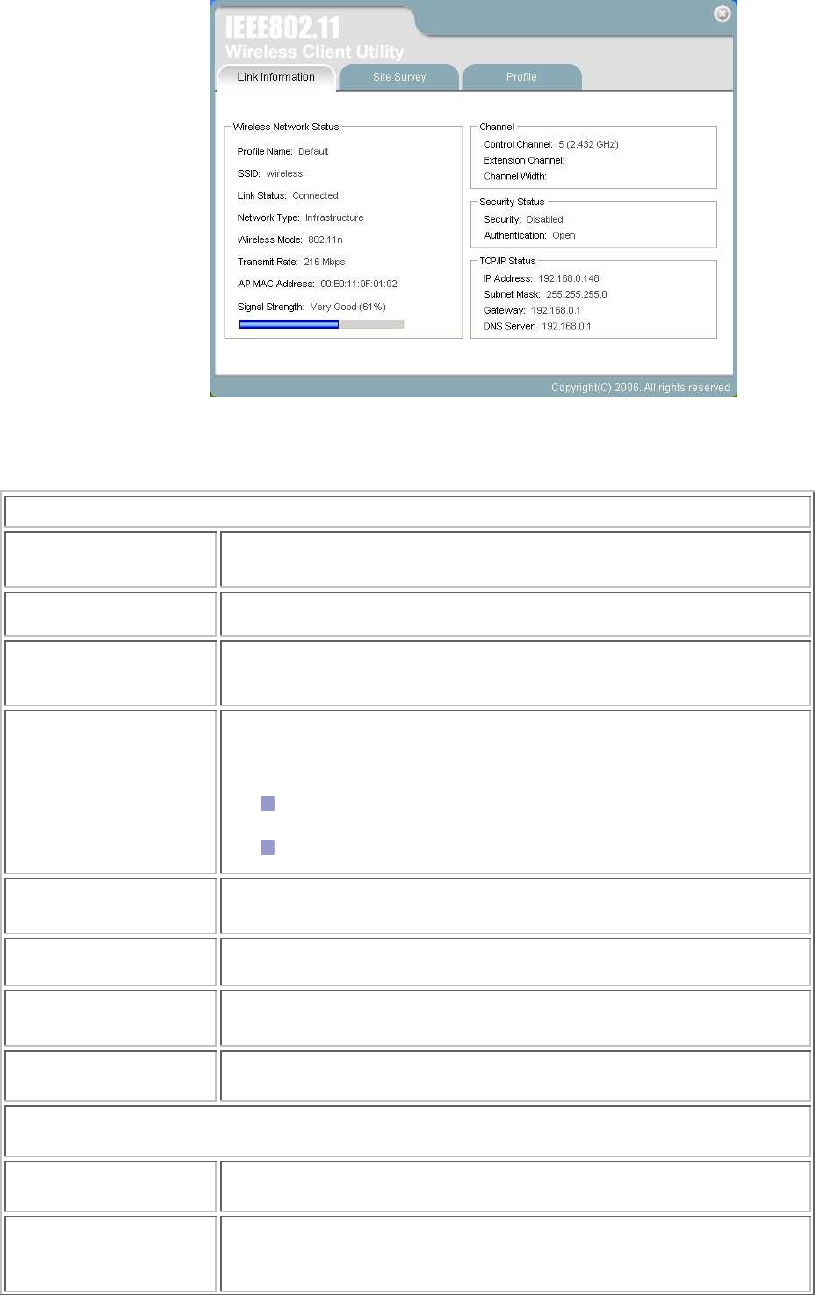
19
The following table describes the items found on the Link Information screen.
Wireless Network Status
Profile Name
The name of the current selected configuration profile. Set
up the configuration name on the Profile tab.
SSID
Displays the wireless network name.
Link Status
Shows whether the station is associated to the wireless
network.
Network Type
The type of network the station is connected to. The options
include:
Infrastructure (access point)
Ad Hoc
Wireless Mode
Displays the wireless mode. 802.11g, 11b or 11n
Transmit Rate
Displays the current transmit rate in Mbps.
AP MAC Address
Displays the MAC address of the access point the wireless
card is associated to.
Signal Strength
Shows the strength of wireless signal.
Channel
Control Channel
Channel number of the control 20MHz channel
Extension Channel
To locate the 40MHz channel on combination with the control
channel
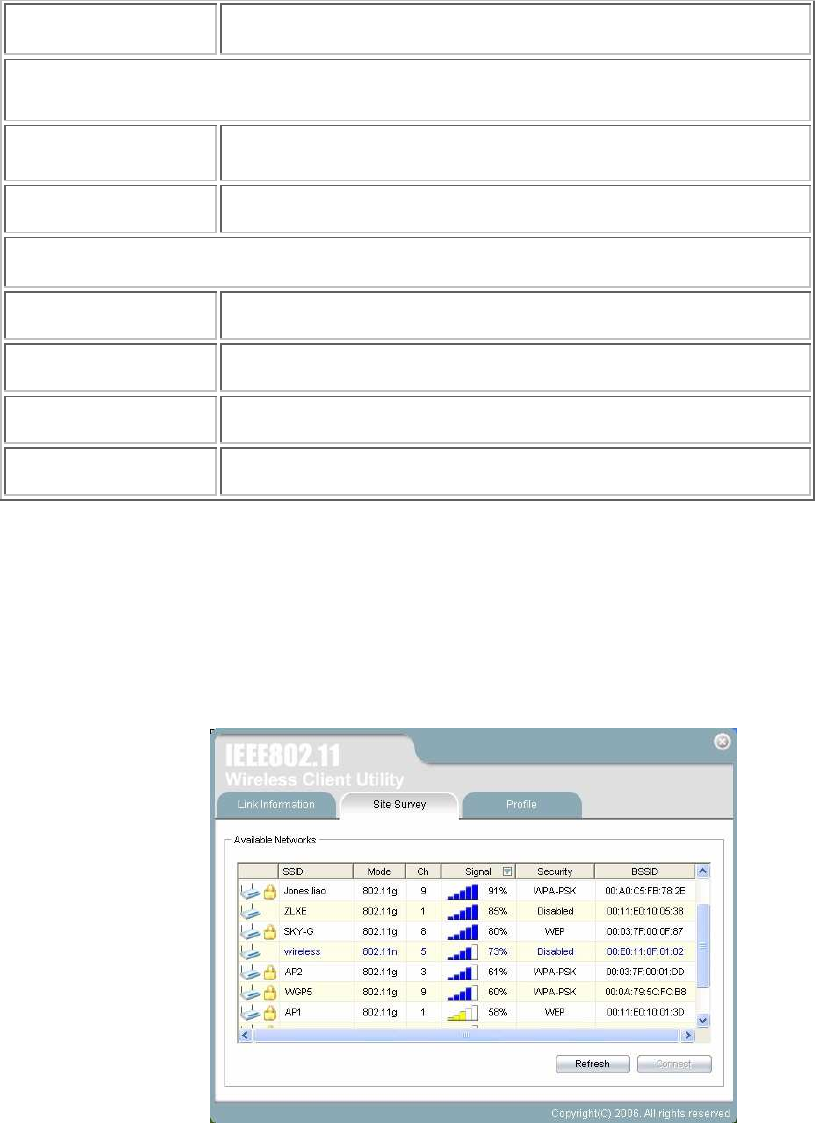
20
Channel Width
20MHz only or 40/20MHz channel support
Security Status
Security
Shows the security type – Disable, WEP, WPA/WPA2,
WAP-PSK/WAP2-PSK or 802.1X
Authentication
Displays the authentication mode.
TCP/IP Status
IP Address
Displays the computer's IP address.
Subnet Mask
Displays subnet mask
Gateway
Displays gateway address
DNS Server
Display DNS server address
Site Survey
Click the Site Survey
Site SurveySite Survey
Site Survey tab to see available infrastructure and ad hoc networks.
On this screen, click Refresh
RefreshRefresh
Refresh to refresh the list at any time.
Connecting to a different network
Connecting to a different networkConnecting to a different network
Connecting to a different network
Hold your mouse pointer over the network icon, and click the right mouse button to select the network.
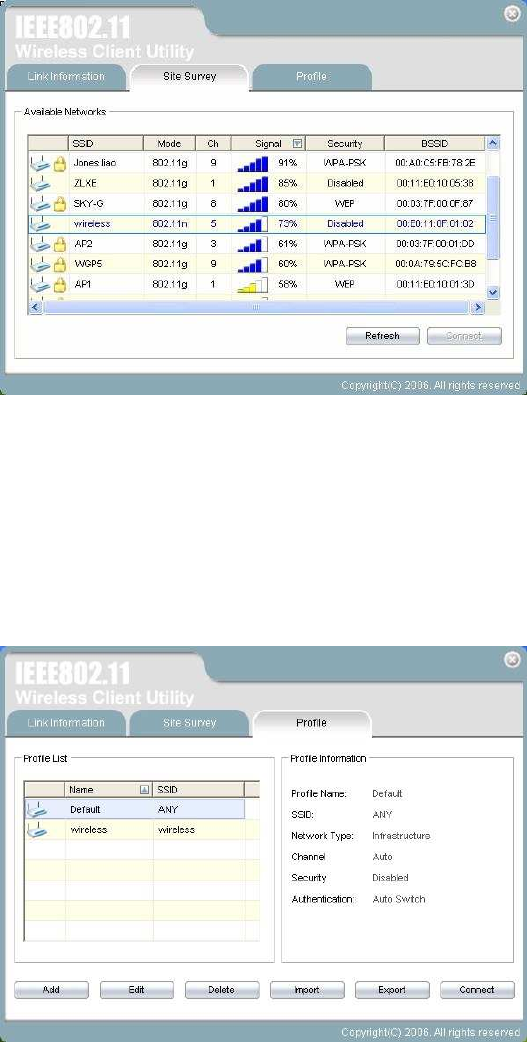
21
Click the Connect
ConnectConnect
Connect button to connect the available network. If no configuration profile exists for that
network, the Profile Settings window opens to ask to create a profile for the network. Follow the
procedures to create profile for that network.
Profile
To add a new configuration profile, click Add on the Profile tab.
To modify a configuration profile, select the configuration from the Profile list and click the Edit button.
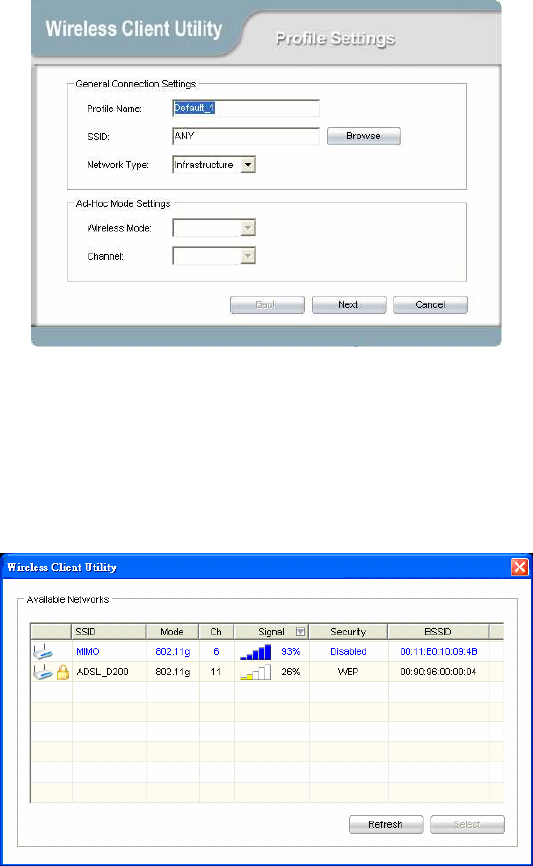
22
Scan Available Networks
Scan Available NetworksScan Available Networks
Scan Available Networks
Click the Browse
BrowseBrowse
Browse button on the Profile Settings screen to scan for available infrastructure and ad hoc
networks. On this list, click Refresh
RefreshRefresh
Refresh to refresh the list at any time.
To configure a profile for Ad-Hoc or Infrastructure mode, select the Network Type field on the Profile
Settings.
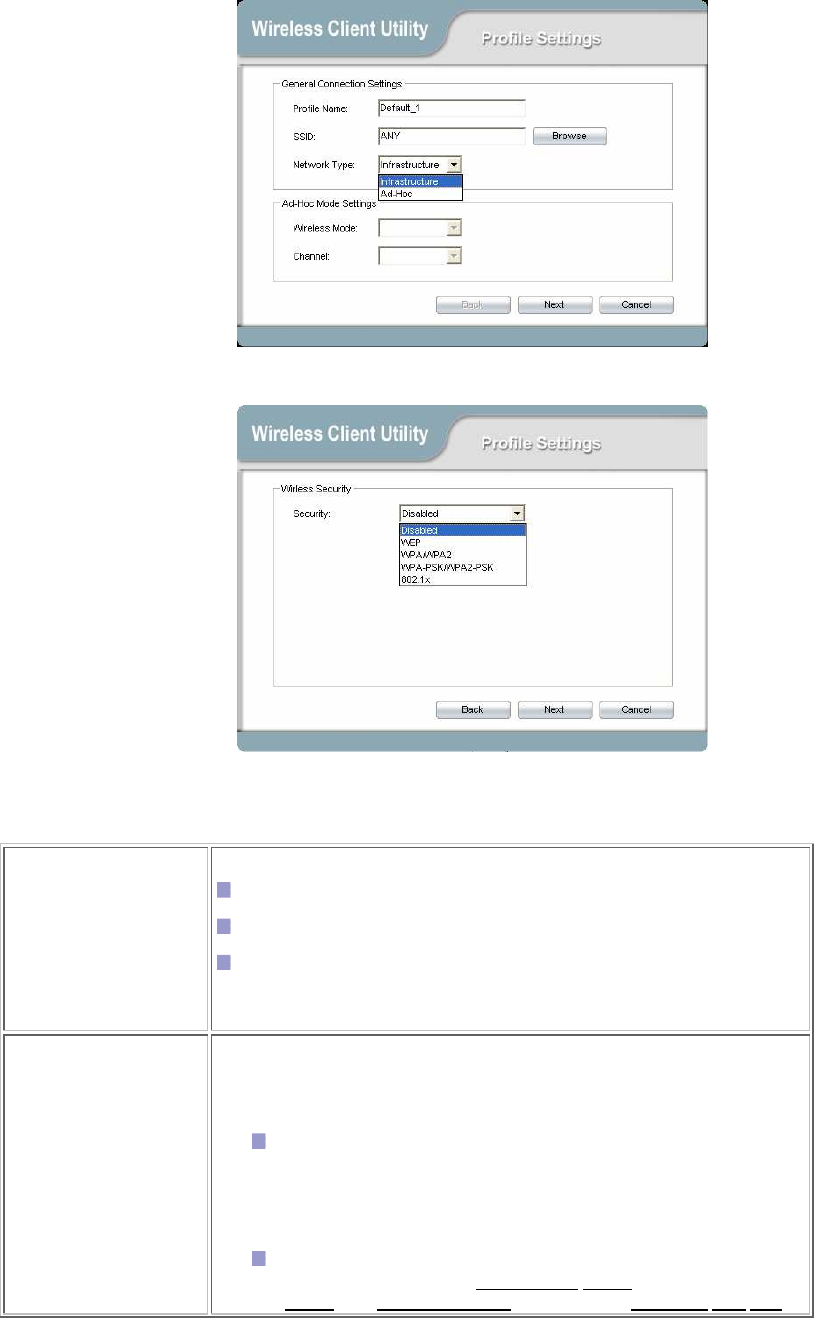
23
Click Next to continue the profile setting.
To define the security mode, select the security button of the desired security mode. And then click Next to
continue. Please see following table for details of security modes.
WEP
This card support three modes of WEP, include:
64 Bits
128 Bits
152 Bits
Except 152-Bit ode, both 64-Bit & 128-Bit modes support
Passphrase.
WPA/WPA2
Enables the use of Wi-Fi Protected Access (WPA).
Choosing WPA/WPA2 opens the WPA/WPA2 Security Settings
screen. The options include:
TLS
(Transport Layer Security) is a Point-to-Point Protocol
(PPP) extension supporting additional authentication methods
within PPP. Transport Layer Security (TLS) provides for mutual
authentication, integrity-protected cipher suite negotiation, and key
exchange between two endpoints
.
PEAP (EAP-GTC)
(
Protected Extensible Authentication
Protocol) authenticates wireless LAN clients using only
server-side digital certificates by creating an encrypted SSL/TLS

24
tunnel between the client and the authentication server. The tunnel
then protects the subsequent user authentication exchange.
PEAP (EAP-MSCHAP V2)
(
Protected Extensible
Authentication Protocol)
To use PEAP (EAP-MSCHAP V2)
security, the server must have WPA-PEAP certificates, and
the server properties must already be set. Check with the IT
manager
TTLS
(Tunneled Transport Layer Security) An EAP variant that
provides mutual authentication using a certificate for server
authentication, and via a secure TLS tunnel for the client
LEAP (Lightweight and Efficient Application Protocol)
is the general framework for a set of high-performance,
efficient protocols which are ideal for mobile and wireless
applications. LEAP is designed to address all the technical
requirements of the wireless data communications industry,
and is oriented towards providing the greatest benefit to the
industry and the consumer
WPA-PSK/WPA2-
PSK
Enables WPA/WPA2 Passphrase security.
Fill in the WPA/WPA2 Passphrase on Security Settings screen.
802.1x
Enables 802.1x security. This option requires IT administration.
Choosing 802.1x opens the 802.1x Security Settings screen. The
options include:
TLS
PEAP
TTLS
LEAP
Advanced Settings
After Security Settings finished, the Advanced Settings screen will be shown as following.
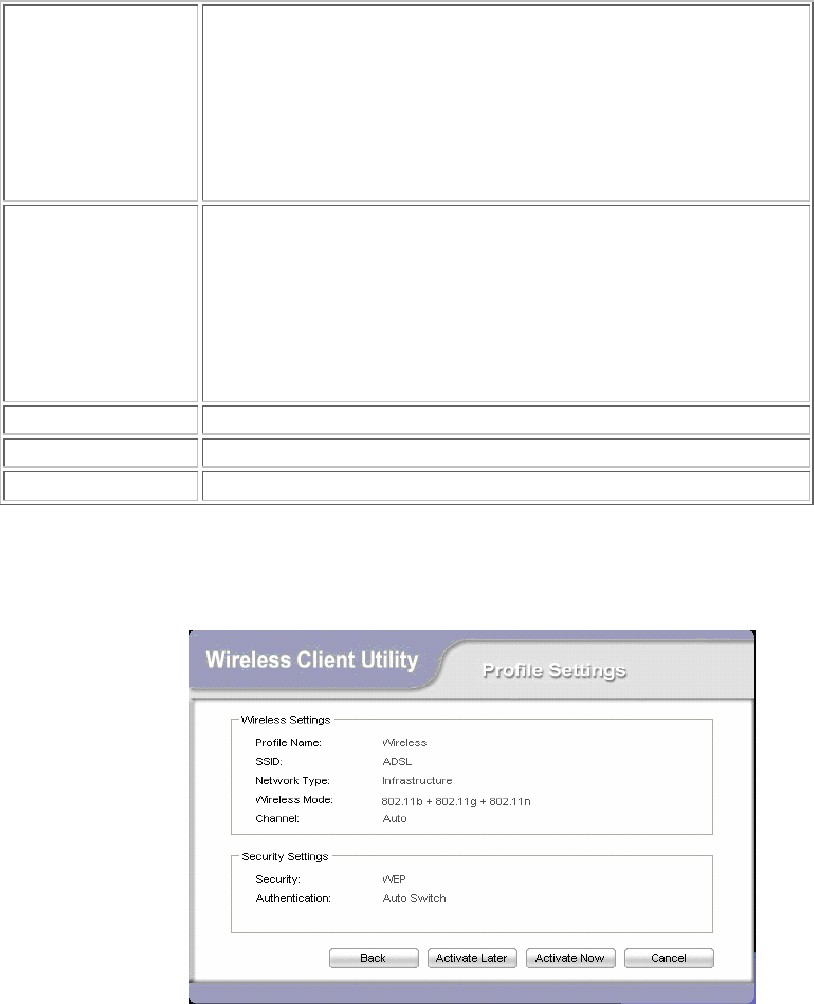
25
The following table describes the items found on the Advanced Settings screen.
Power Save Mode
Shows the power save mode. Power management is disabled in ad
hoc mode.
The options include:
Continuous Access Mode
Maximum Power Saving
Fast Power Saving
802.11b Preamble
Displays the 802.11b preamble format.
The options include:
Long
Short
Auto
RTS Threshold
Value from 0 ~ 2347
FRAG Threshold
Value from 256 ~ 2346
Wireless Mode
Enable or disable 802.11n mode.
After advance settings are finished, the following screen showed as below.
You can activate the profile now or later.
26
Chapter 4 - Maintenance
This chapter describes how to uninstall or upgrade the Wireless Utility.
Uninstall the Driver
Follow the steps below to remove (or uninstall) the Card driver from your computer.
Step 1. To remove the driver from the OS, go to Start -> Control Panel
Step 2. Double-click System
Step 3. Under Hardware tab, click Device Manager.
Step 4. Double-click Network Card
Step 5. Right-click mouse button on “802.11n Wireless LAN Card”, and choose Uninstall
Step 6. Click OK to confirm that you are going to uninstall the driver
Uninstall the Client Utility
Follow the steps below to remove the Client Utility from your computer.
Step 1. To remove the utility from the OS, go to Start -> Control Panel
Step 2. Double-click Add-Remove Programs
Step 3. Select 802.11n Wireless Client Utility, and click the Uninstall button
Upgrading the Wireless Utility
To perform the upgrade, follow the steps below.
Step 1. Download the latest version of the utility from the web site and save the file on your computer.
Step 2. Follow the steps in Section 3.2 to remove the current Wireless Utility from your computer.
Step 3. Restart your computer if prompted.
Step 4. After restarting, refer to the procedure in the Chapter 2 to install the new utility.
27
28
Glossary
For unfamiliar terms used below, look for entries elsewhere in the glossary.
A
D
-H
OC
(IBSS)
Ad-hoc mode does not require an AP or a wired network. A network that transmits wireless
from computer to computer without the use of a base station (access point).
Two or more wireless stations communicate directly to each other. An ad-hoc network may
sometimes be referred to as an Independent Basic Service Set (IBSS).
C
HANNEL
A radio frequency used by a wireless device is called a channel.
EAP A
UTHENTICATION
EAP (Extensible Authentication Protocol) is an authentication protocol that runs on top of the
IEEE802.1X transport mechanism in order to support multiple types of user authentication. By
using EAP to interact with an EAP-compatible RADIUS server, an access point helps a wireless
station and a RADIUS server perform authentication.
E
NCRYPTION
The reversible transformation of data from the original to a difficult-to-interpret format. Encryp-
tion is a mechanism for protecting confidentiality, integrity, and authenticity of data. It uses an
encryption algorithm and one or more encryption keys.
F
RAGMENTATION
T
HRESHOLD
This is the maximum data fragment size that can be sent before the packet is fragmented into
smaller packets.
IEEE 802.1X
The IEEE 802.1X standard outlines enhanced security methods for both the authentication of
wireless stations and encryption key management. Authentication can be done using an external
RADIUS server.
I
NFRASTRUCTURE
(BSS)
When a number of wireless stations are connected using a single AP, you have a Basic Ser-
vice Set (BSS).
R
OAMING
In an infrastructure network, wireless stations are able to switch from one BSS to another as
they move between the coverage areas. During this period, the wireless stations maintain
uninterrupted connection to the network. This is roaming. As the wireless station moves from
place to place, it is responsible for choosing the most appropriate AP depending on the signal
strength, network utilization among other factors.
29
SSID
The SSID (Service Set Identity) is a unique name shared among all wireless devices in a wire-
less network. Wireless devices must have the same SSID to communicate with each other.
T
EMPORAL
K
EY
I
NTEGRITY
P
ROTOCOL
(TKIP)
Temporal Key Integrity Protocol (TKIP) uses 128-bit keys that are dynamically generated and
distributed by the authentication server.
U
SER
A
UTHENTICATION
WPA applies IEEE 802.1X and Extensible Authentication Protocol (EAP) to authenticate wire-
less clients using an external RADIUS database. If you do not have an external RADIUS server,
use WPA-PSK/WPA2-PSK (WPA -Pre-Shared Key) that only requires a single (identical)
password entered into each access point, wireless gateway and wireless client. As long as the
passwords match, clients will be granted access to a WLAN.
WEP
WEP (Wired Equivalent Privacy) encryption scrambles all data packets transmitted between
the WPC-370A and the AP or other wireless stations to keep network communications private.
Both the wireless stations and the access points must use the same WEP key for data
encryption and decryption.
WPA/PA2
Wi-Fi Protected Access (WPA) and WPA2 is a subset of the IEEE 802.11i security
specification draft. Key differences between WPA and WEP are user authentication and
improved data encryption. WPA2 is a wireless security standard that defines stronger
encryption, authentication and key management than WPA
48